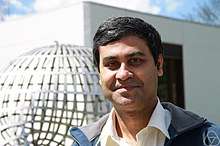Tamal Dey
Tamal Krishna Dey (born 1964)[1] is an Indian mathematician and computer scientist specializing in computational geometry and computational topology. He was a former professor and chair of the department of computer science and engineering at the Ohio State University.

Education and career
Dey graduated from Jadavpur University in 1985, with a bachelor's degree in electronics. He earned a master's degree from the Indian Institute of Science Bangalore in 1987, and completed his Ph.D. at Purdue University in 1991.[2] His dissertation, Decompositions of Polyhedra in Three Dimensions, was supervised by Chandrajit Bajaj.[3]
After postdoctoral research with Herbert Edelsbrunner at the University of Illinois at Urbana–Champaign, Dey joined the Purdue faculty in 1992. He moved to the Indian Institute of Technology Kharagpur in 1994, and moved again to Ohio State in 1999. At Ohio State, he has also held a courtesy appointment in the department of mathematics since 2015.[2]
Contributions
Dey is known for proving the tightest-known upper bounds on the k-set problem[4] and for his work on 3D reconstruction and computational topology.
He is the author of the book Curve and Surface Reconstruction: Algorithms with Mathematical Analysis (Cambridge University Press, 2006).[5] With Siu-Wing Cheng and Jonathan Shewchuk, he is the co-author of Delaunay Mesh Generation (CRC Press, 2012).[6]
Recognition
Dey was elected as an ACM Fellow in 2018 for "contributions to computational geometry and computational topology".[7] He is also a fellow of the IEEE.[2]
References
- Birth year from Library of Congress catalog entry, retrieved 2018-12-06.
- Curriculum vitae (PDF), retrieved 2018-12-06
- Tamal Dey at the Mathematics Genealogy Project
- Mitchell, Joseph S. B.; O'Rourke, Joseph (2001), "Computational geometry column 42", International Journal of Computational Geometry & Applications, 11 (5): 573–582, arXiv:cs/0001025, doi:10.1142/S0218195901000651, MR 1862888
- Sottile, Matthew J. (March 2010), "Review of Curve and Surface Reconstruction: Algorithms with Mathematical Analysis", ACM SIGACT News, 41 (1): 24, doi:10.1145/1753171.1753178
- Bihlo, Alexander, "Review of Delaunay Mesh Generation", Mathematical Reviews, MR 3156288
- 2018 ACM Fellows Honored for Pivotal Achievements that Underpin the Digital Age, Association for Computing Machinery, December 5, 2018
External links
- Home page
- Tamal Dey publications indexed by Google Scholar